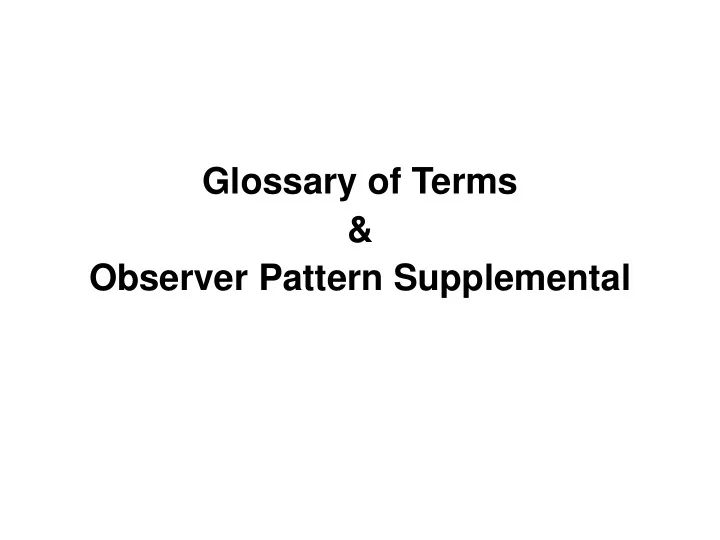

Glossary of Terms & Observer Pattern Supplemental
DRY Don't Repeat Yourself Repetition = redundancy. Extra work keeping everything in sync. You'll probably miss one of the repetitions. Source of subtle hard-to-find bugs.
Cohesion The degree to which a component addresses a single, well- defined issue. Component can be: A method A class A subsystem of classes We want systems with high cohesion .
Separation of Concerns Each component addresses a single, separate design concern. A concern is a well-define aspect of the problem being solved. SOC tends towards highly-cohesive components. Do One Thing Well.
Class Responsibilities What do the objects in a class know ? Internal state Instance variables What can the objects in a class do ? Visible behavior. Public methods Do nothing significant = data class - bad karma. A class must pull its weight in the overall design. Know nothing significant = algorithm class - may be ok.
Coupling Coupling is the manner and degree of interdependence between software modules. Not just a count of the number of dependent classes. Also need the degree of dependence: How easy is it to update this component? How easy is it to replace a dependent component? In general, the less the interdependence - the lower the coupling - the better.
Technical Debt (Code Debt) Work that needs to be done before a particular job can be considered properly complete. Debt not repaid keeps on accumulating interest , making it hard to implement changes later on. Debt is not necessarily bad as long as you control it . Uncontrolled financial debt leads to bankruptcy. Uncontrolled technical debt leads to systems that can't adapt (and may need to be scrapped. Working under heavy code debt is as much fun as kicking a dead whale along the beach.
Refactoring Restructuring existing code without changing its external behavior. To improve nonfunctional attributes such as readability, maintainability, and design integrity. One technique to help keep technical debt under control. Little at a time refactoring vs. "big bang" refactoring. Refactor a bit, enhance a bit.
How did we refactor WS?
Design Pattern The re-usable form of a general solution to a common design problem. Christopher Alexander in The Timeless Way of Building : Each pattern describes a problem that occurs over and over again in our environment, and then describes the core of the solution to that problem, in such a way that you can use this solution a million times over, without ever doing it the same way twice . Software design patterns are the essence of empirically proven solutions to common design problems.
Observer Pattern Define a one-to-many dependency between objects so that when the one object (A) changes state, all its dependents (B) are notified and updated automatically. Don't want to maintain the consistency by tightly coupling (A) to the dependents (B). Those interested, Observers , register interest in changes to the Subject object. When the Subject changes, it notifies all registered Observers by calling a generic update() method. Particular names - notify , update , Observer , Subject, etc. - are not fixed; they just indicate roles and responsibilities!
O R
Observer in Java Interface java.util.Observer [implementable Observer] public interface Observer { public void update(Observable obs, Object obj) ; } Class java.util.Observable [extendable Subject] public class Observable { public void addObserver(Observer obs) ; public void deleteObserver(Observer obs) ; public void setChanged() ; public void clearChanged() ; public boolean hasChanged() ; public void notifyObservers() ; public void notifyObservers(Object arg) ; }
Recommend
More recommend